

System.Net.Mail Namespace () System.Net.Mail, OH MY! Template. Die Clean Code Developer Grade - Clean Code Developer.
Hauptseite Theoretische Informatik. GetReferencedAssemblies-Methode. .NET Framework Unterstützt in: 4.5, 4, 3.5, 3.0, 2.0, 1.1, 1.0 .NET Framework Client Profile Unterstützt in: 4, 3.5 SP1 Windows 8.1, Windows Server 2012 R2, Windows 8, Windows Server 2012, Windows 7, Windows Vista SP2, Windows Server 2008 (Server Core-Rolle wird nicht unterstützt), Windows Server 2008 R2 (Server Core-Rolle wird mit SP1 oder höher unterstützt; Itanium wird nicht unterstützt)
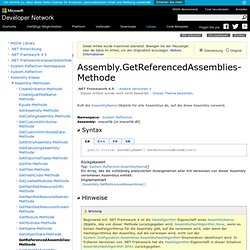
Fluent Interface. Fluent Interfaces[1] (deutsch oft übersetzt mit: „flüssige Schnittstellen“, treffender etwa: „sprechende Schnittstellen“) sind ein Konzept für Programmierschnittstellen in der Software-Entwicklung, bei dessen Befolgung man beinahe in Form von Sätzen natürlicher Sprache programmieren kann.

Der danach verfasste Programmcode ist gut lesbar und erleichtert das Verständnis des Programms. Schnittstellen werden oft falsch verwendet. Fluent Interfaces können zu ihrer richtigen Verwendung anhalten, indem für sie eine Grammatik gewählt wird, die von falschen Verwendungen erkennbar verletzt wird. Es gibt zwei Arten, solche „sprechende Schnittstellen“ zu realisieren, mittels Method Chaining[2] (Methodenketten) oder mittels Nested Functions[3] (Eingebetteten Funktionen). Sprachelemente von C-Sharp. Dieser Artikel bietet eine Übersicht einiger Sprachelemente von C#.
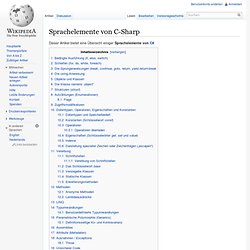
Bedingte Ausführung (if, else, switch)[Bearbeiten] Der sogenannte if-Block hat zur Folge, dass die zwischen den geschweiften Klammern liegenden Anweisungen nur dann in Kraft treten, wenn die angegebene Bedingung erfüllt ist, d. h. ihr Wert true ist. Der else-Block, der nur in Verbindung mit einem if-Block stehen kann, wird nur dann ausgeführt, wenn die Anweisungen des if-Blocks nicht ausgeführt wurden. MSDN Webcasts - Visual Studio, .NET Framework, Silverlight. Videos und Tutorials auf Videorial - Lern es Dir selbst. "How Do I?" Videos for Visual Studio 2008.
Reflection in .NET. Cook Computing - RemotingException and Missing Channel Sinks. RemotingException and Missing Channel Sinks September 4, 2003Written by Charles Cook The .NET exception type RemotingException can be thrown for various reasons, including two situations in which it is thrown with the following message: An unhandled exception of type 'System.Runtime.Remoting.RemotingException' occurred in mscorlib.dll Additional information: This remoting proxy has no channel sink which means either the server has no registered server channels that are listening, or this application has no suitable client channel to talk to the server.
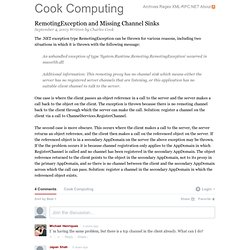
One case is where the client passes an object reference in a call to the server and the server makes a call back to the object on the client. The exception is thrown because there is no remoting channel back to the client through which the server can make the call. Strings formatieren mit C# C# - String in Byte Array und zurück wandeln. Events Tutorial (C#) This tutorial shows how to declare, invoke, and hook up to events in C#.

Sample Files Further Reading Tutorial An event in C# is a way for a class to provide notifications to clients of that class when some interesting thing happens to an object. The most familiar use for events is in graphical user interfaces; typically, the classes that represent controls in the interface have events that are notified when the user does something to the control (for example, click a button). Interface layout - cbrumme's WebLog. The CLR has two different techniques for implementing interfaces.
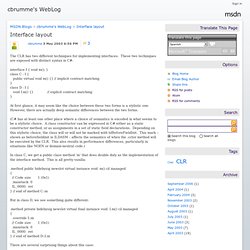
These two techniques are exposed with distinct syntax in C#: interface I { void m(); } Implicit and Explicit Interface Implementations - Michael Hopcroft. C# Tutorial - XML Serialization. A long while ago we posted a tutorial on how to serialize objects to a binary file.
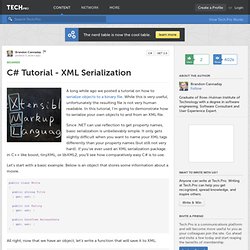
While this is very useful, unfortunately the resulting file is not very human readable. In this tutorial, I'm going to demonstrate how to serialize your own objects to and from an XML file. Since .NET can use reflection to get property names, basic serialization is unbelievably simple. It only gets slightly difficult when you want to name your XML tags differently than your property names (but still not very hard). If you've ever used an XML serialization package in C++ like boost, tinyXML, or libXML2, you'll see how comparatively easy C# is to use. Let's start with a basic example. Public class Movie{ public string Title { get; set; } public int Rating { get; set; } public DateTime ReleaseDate { get; set; }} All right, now that we have an object, let's write a function that will save it to XML. After this code executes, we'll have an XML file with the contents of our movie object.
<? <? <? <? Microsoft Kills Its Oracle Data Provider for ADO.NET. Interop Forms Toolkit 2.1. Interop Forms Toolkit 2.0 Tutorial. Why use the Interop Toolkit?
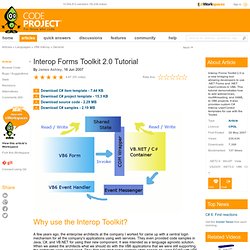
A few years ago, the enterprise architects at the company I worked for came up with a central login mechanism for all the company's applications using web services. They even provided code samples in Java, C#, and VB.NET for using their new component. It was intended as a language agnostic solution. When we asked the architects what we should do with the VB6 applications that we were still supporting, the architects were nonplussed.
They first provided some esoteric white papers on using SOAP with VB6, then they suggested that we upgrade all of our VB6 apps to .NET, and finally, they conceded that VB6 apps simply didn't have a place in their solution. Steckspiele - Event-Based Components verbinden. Wie ich hier erklärt habe, liegen mir die “traditionellen” Komponenten – bei aller Liebe – doch auch ein wenig im Magen.
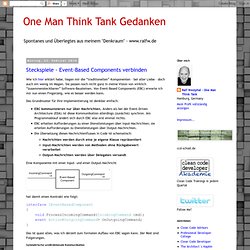
Sie passen noch nicht ganz in meine Vision von wirklich “zusammensteckbaren” Software-Bausteinen. Von Event-Based Components (EBC) erwarte ich mir nun einen Fingerzeig, wie es besser werden kann. Das Grundmuster für Ihre Implementierung ist denkbar einfach: EBC kommunizieren nur über Nachrichten. Styleguide. Bitte beachten Sie, dass sich diese Seite derzeit im Aufbau befindet und daher noch nicht in ihrer endgültigen Form vorliegt.

Übersicht Ausnahmen definieren Als Basis für eigene Ausnahmen stehen in .NET zwei Klassen zur Verfügung: Exception und ApplicationException, die sich beide im Namensraum System befinden. Ursprünglich war die Klasse Exception den .NET-eigenen Ausnahmen als Basisklasse vorbehalten, eigendefinierte Ausnahmen sollten von ApplicationException abgeleitet werden. Da die Verwendung der Klasse ApplicationException in der Praxis allerdings keine Vorteile birgt, wird ihre Verwendung seit der Version 3.0 von .NET nicht mehr empfohlen. Mehrsprachigkeit / Lokalisierung in WPF. Folgender Artikel beschreibt die technische Umsetzung zweier Methoden um WPF Anwendungen mehrsprachig zu gestalten.
Mögliche Lösungsansätze: Themen - codekicker.de.